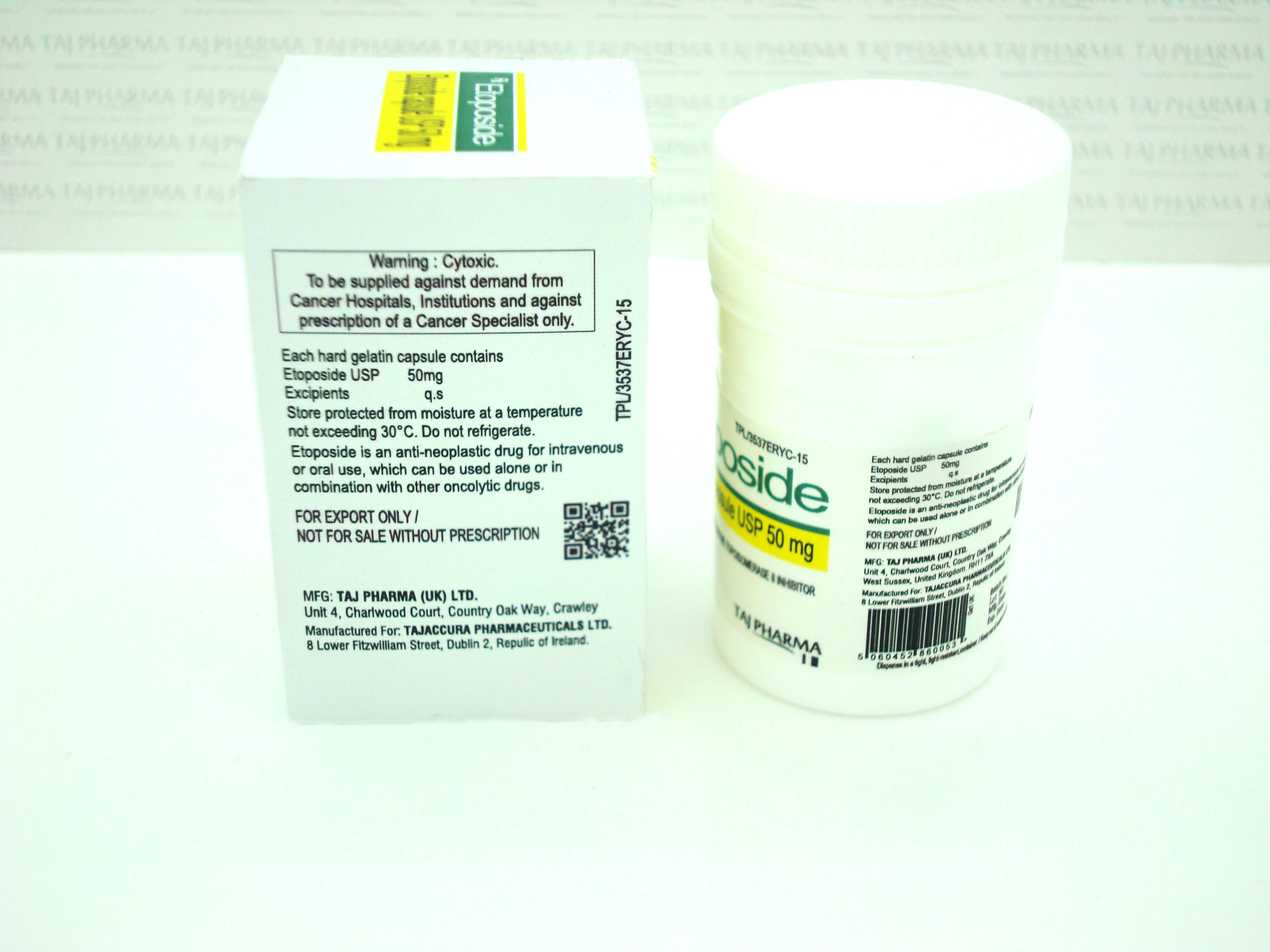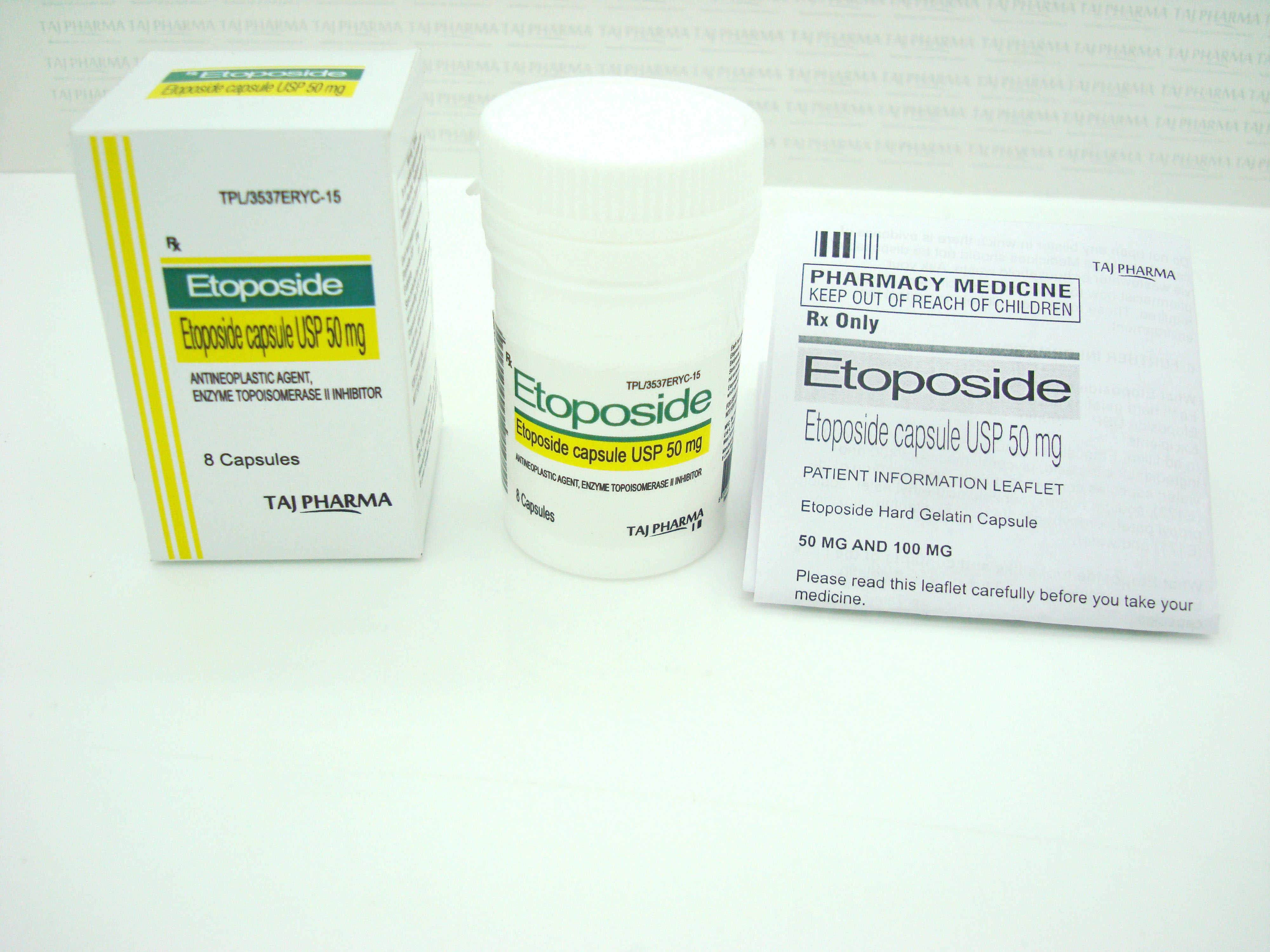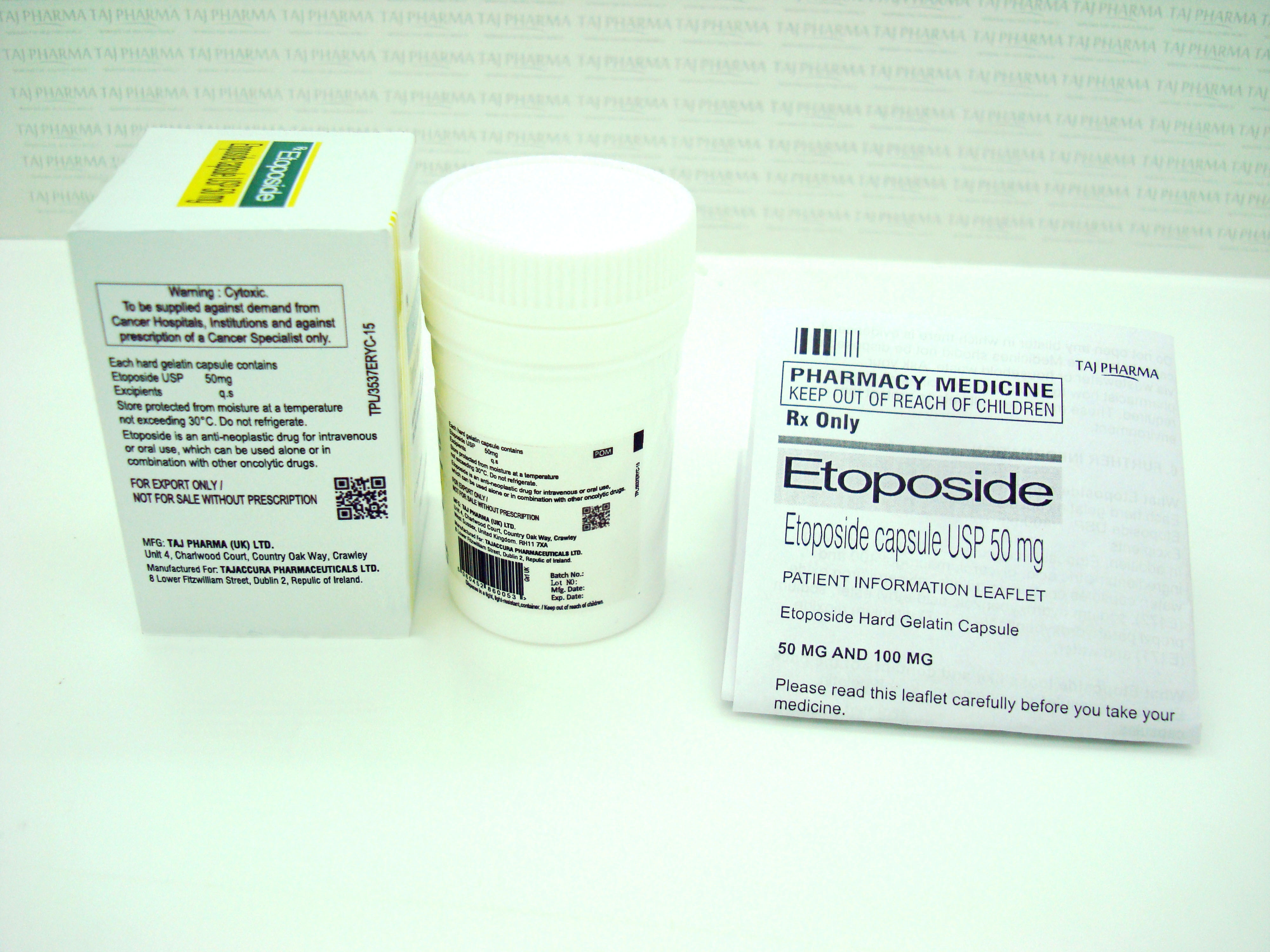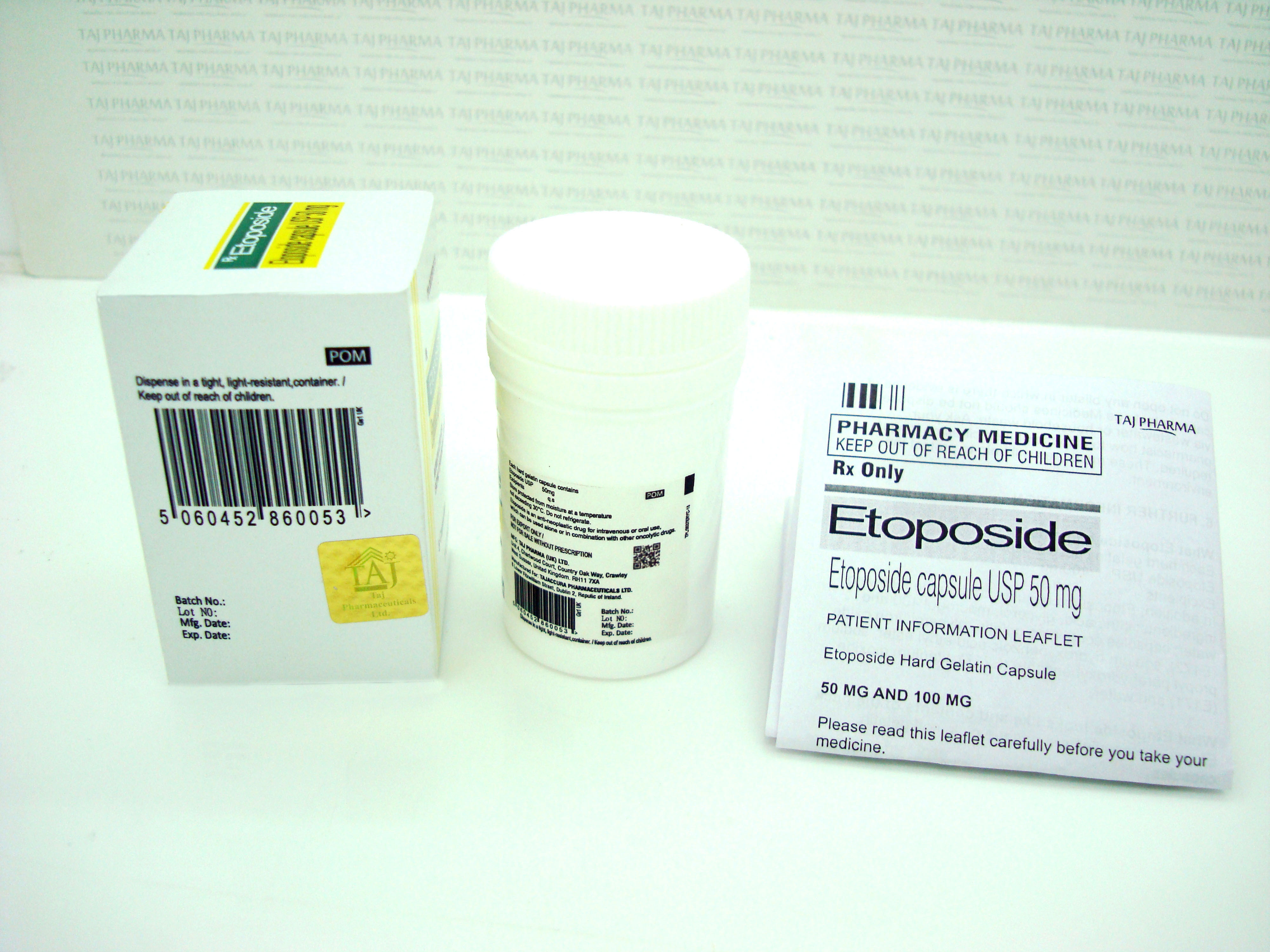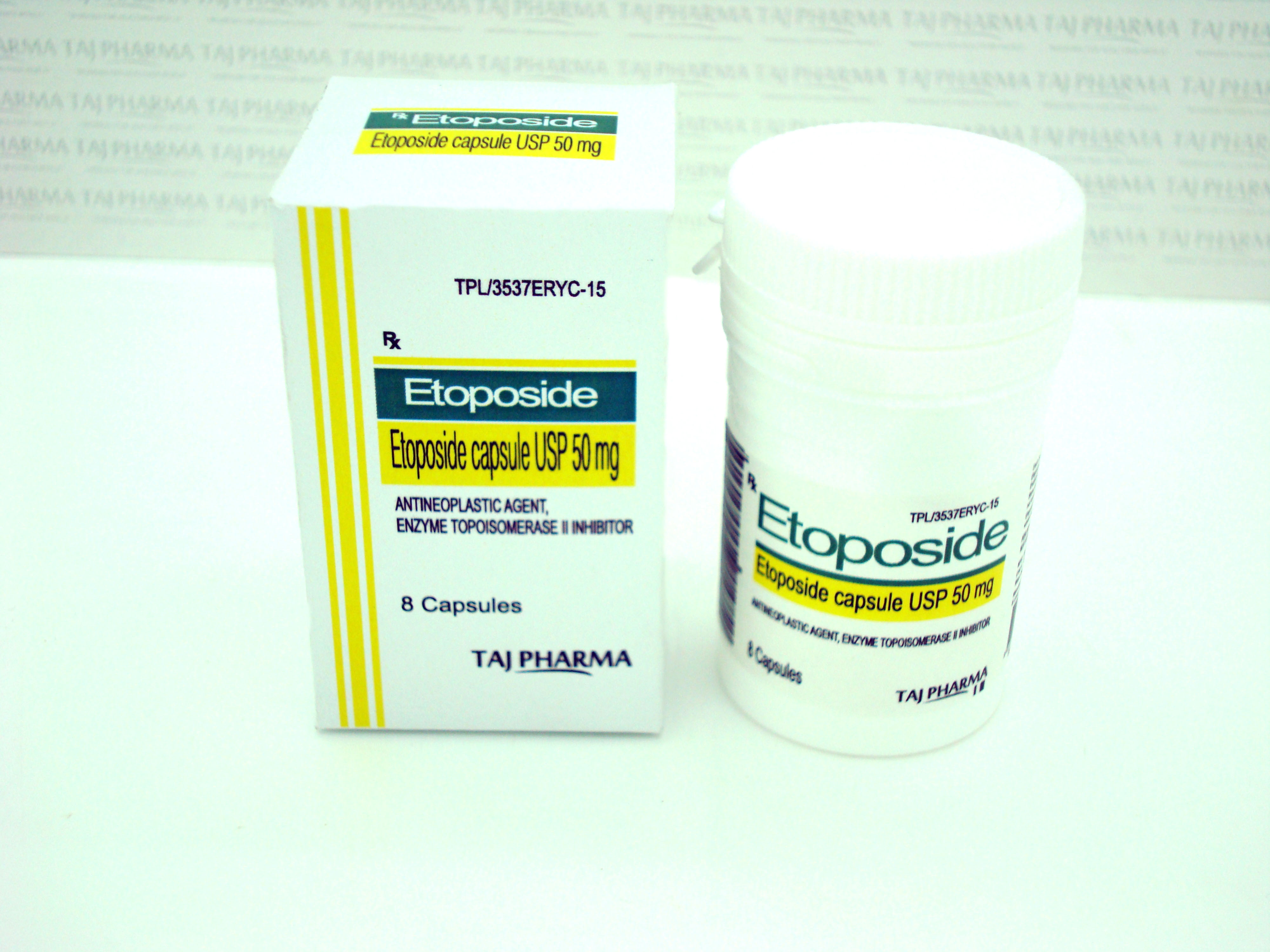Etoposide 25mg/50mg/100mg Capsules
Etoposide
50mg Capsules
Storage
Etoposide capsules should be stored below 25°C.
Do not store Etoposide capsules or any other medicine in the bathroom or near a sink.
Do not leave them in the car on a hot day or on window sills.
Heat or dampness can destroy some medicines.
Keep Etoposide capsules where children cannot reach them.
A locked cupboard at least one-and- a-half metres above the ground is a good place to store medicines.
Product description
What it looks like
Etoposide Capsules are pink oblong capsules, in either 50mg or 100mg strengths.
Etoposide 50mg capsules are supplied in blister packs of either 10 or 20 capsules.
Etoposide 100mg capsules are supplied in blister packs of 10 capsules.
Ingredients
CAPSULES:
Active: The active ingredient in capsules is etoposide.
Each capsule either contains 50mg of etoposide or 100mg of etoposide.
Inactive: Each capsule also contains citric acid, glycerol, macrogol 400 gelatin, parabens, titanium dioxide & iron oxide pigment
Etoposide
50mg Capsules
What Etoposide is used for
- Etoposide is used to treat lung cancer, leukaemia (blood cancer) and cancer of the lymph glands. The Capsule contains Etoposide, an anti-cancer medicine. It interferes with the development of cells and causes cell death, particularly in cancer cells.
- Etoposide may be used alone or in combination with other medicines to treat cancer. Your doctor will inform you if this is necessary.
- Your doctor may have prescribed Etoposide for another reason. Ask your doctor if you have any questions about why Etoposide was prescribed for you.
Before you are given Etoposide
When you must not be given it
Do not take Etoposide if you have an allergy to Etoposide, or any of the ingredients listed at the end of this leaflet, unless you have discussed it with your doctor.
Symptoms of an allergic reaction may include:
- chills/fever
- fast heart beat
- difficulty in breathing, shortness of breath
- dizziness or lightheadedness
Do not take Etoposide if you have, or have had any of the following medical conditions, unless you have discussed it with your doctor:
- liver problems
- kidney problems
- your immune system is not working properly (you get a lot of infections requiring treatment with antibiotics)
- a blood disorder with a reduced number of white blood cells
- a blood disorder in which there is a decreased number of red blood cells
- a blood disorder with a low blood platelet count
- lowered immunity due to treatment with medicines such as corticosteroids, cyclosporin or other medicines used to treat cancer
Tell your doctor if you have an infection or high temperature.
Your doctor may decide to delay your treatment until the infection has gone.
- Do not take Etoposide if you have had recent surgery.
- Do not take Etoposide if you are receiving radiation therapy or any other medicine, which lowers your immune system.
- Do not take Etoposide if you are pregnant or intend to become pregnant.
Like most medicines used to treat cancer, Etoposide is not recommended for use during pregnancy, unless you and your doctor have discussed the risks and benefits involved.
- You should use some kind of birth control while you are having Etoposide and for at least 12 weeks after you stop using it.
Etoposide may cause birth defects if either the male or female is using it at the time of conception.
- Do not breastfeed while having Etoposide, unless you have discussed it with your doctor.
It is not known whether Etoposide passes into breast milk. Therefore there is a possibility that the breast-fed baby may be affected.
- If you have not told your doctor about any of the above, tell them before you start Etoposide.
- If you are not sure whether you should have Etoposide, talk to your doctor.
Before you are given it
Tell your doctor if you have allergies to:
- any other medicines
- any other substances, such as foods, preservatives or dyes
Tell your doctor if you have or have had any medical conditions, especially the following:
- liver problems
- kidney problems
- a blood disorder with a reduced number of white blood cells
- a blood disorder in which there is a decreased number of red blood cells
- a blood disorder with a low blood platelet count
- lowered immunity due to treatment with medicines such as corticosteroids, cyclosporin or
other medicines used to treat cancer
- lowered immunity due to treatment with medicines such as corticosteroids, cyclosporin or other medicines used to treat cancer (including radiation therapy)
Tell your doctor if you are pregnant or intend to become pregnant.
Tell your doctor if you are breast-feeding or plan to breastfeed.
If you have not told your doctor about any of the above, tell them before you start taking Etoposide.
Taking other medicines
Tell your doctor if you are taking
any other medicines, including anythat you buy without a prescription from your pharmacy, supermarket or health food shop.
Some medicines and Etoposide may interfere with each other. These include:
- Some other medicines that are used to treat other forms of cancer
- Cyclosporin - a medicine used to prevent rejection of transplanted organs
These medicines may be affected by Etoposide, or affect how well it works. You may need different amounts of your medicine, or you may need to have different medicines. Your doctor will advise you.
Your doctor may have more information on medicines to be careful with or avoid while taking Etoposide.
How Etoposide is given
How much is given
- Your doctor will decide what dose you will receive. Your dose of Etoposide capsules are worked out based on your body weight and height and on the type of cancer you have. The dose worked out for you may be different to the dose for another patient.
- Etoposide may be given alone or in combination with other anti-cancer drugs. Several courses of Etoposide therapy may be needed depending on your response to treatment.
- Additional treatment may not be repeated until your blood cell numbers return to acceptable levels and any uncontrolled effects have been controlled.
- Ask your doctor if you want to know more about the dose of Etoposide you receive.
How it is given
Them yourself at home. You must only take Etoposide capsules with water preferably on an empty stomach.
If you forget to take Etoposide capsules
If you are taking Etoposide capsules at home and you forget to take a dose - if it is almost time for your next dose, skip the dose you missed and take your next dose when you are meant to.
Otherwise, take it as soon as you remember, and then go back to taking your medicine as you would normally.
Do not take a double dose to make up for the dose that you missed.
This may increase the chance of you getting an unwanted side effect.
How long it is given
Etoposide is usually given each day for 5 days. This is followed by a treatment-free interval of 2-4 weeks. This is called one cycle of chemotherapy. Your doctor will decide how many of these cycles you will need. Etoposide may be given at the same time as other anti-cancer agents, or may be given alone.
Overdose
Immediately telephone your doctor or pharmacist or the Poisons Information Centre or go to Accident or Emergency at your nearest hospital, if you think that you or someone else may have taken too many Etoposide capsules.
Do this even if there are no signs of discomfort or poisoning. You may need urgent medical attention.
Symptoms of overdose may include collapse, kidney failure, liver failure, failure of the immune system, and continuing nausea and/or vomiting.
While you are using Etoposide
Things you must do
Be sure to keep all your doctor©s appointments so your progress can be checked.
Your doctor may want to check your blood pressure and do some blood and other tests from time to time to check on your progress and detect any unwanted side effects.
Keep follow up appointments with your doctor
It is important to have your follow-up infusions of Etoposide at the appropriate time to get the best effect from your treatments
If you forget an appointment, contact your doctor immediately.
Tell any other doctors, dentists and pharmacists who are treating you that you are taking Etoposide.
If you are about to be started on any new medicine, tell your doctor, dentist or pharmacist that you are taking Etoposide.
If you plan to have surgery that needs a general anaesthetic, tell your doctor or dentist that you are taking Etoposide.
If you become pregnant while taking Etoposide, tell your doctor.
Etoposide can lower the number of white blood cells and platelets in your blood. This means that you have an increased chance of getting an infection or bleeding. The following precautions should be taken to reduce your risk if infection or bleeding:
- Avoid people who have infections. Check with you doctor immediately if you think you may be getting an infection, or if you get a fever, chills, cough, hoarse throat, lower back or side pain or find it painful or difficult to urinate.
- Be careful when using a toothbrush, toothpick or dental floss. Your doctor, dentist, nurse or pharmacist may recommend other ways to clean your teeth and gums. Check with your doctor before having any dental work.
- Be careful not to cut yourself when you are using sharp objects such as a razor or nail cutters.
- Avoid contact sports or other situations where you may bruise or get injured.
Things you must not do
Do not give Etoposide to anyone else, even if they have the same condition as you.
Do not take Etoposide to treat any other complaints unless your doctor tells you to.
Do not stop taking Etoposide, or lower the dose, without checking with your doctor.
Things to be careful of
Be careful driving or operating machinery until you know how Etoposide affects you.
As with other medicines used to treat cancer, Etoposide may cause dizziness, light-headedness or tiredness in some people. Make sure you know how you react to Etoposide before you drive a car, operate machinery, or do anything else that could be dangerous if you are dizzy or light-headed. If this occurs do not drive. If you drink alcohol, dizziness or light-headedness may be worse.
Side effects
Tell your doctor or nurse as soon as possible if you do not feel well while you are having Etoposide.
Like other medicines that treat cancer, Etoposide may have unwanted side effects, some of which may be serious. You may need medical treatment if you get some of the side effects.
Ask your doctor to answer any questions you may have.
Tell your doctor or nurse if you notice any of the following and they worry you:
These are the more common side effects of Etoposide.
- nausea, vomiting, diarrhoea, constipation, stomach pain or discomfort
- loss of appetite, aftertaste
- sore mouth, problems swallowing
- unusual hair loss or thinning
- dizziness
- feeling tired or down,
- rash, itchy skin, discolouration of skin
Tell your doctor or nurse as soon as possible if you notice any of the following:
These may be serious side effects. You may need medical attention.
- itching of the skin, joint aches, blisters that look like hives on the upper body, legs, arms, palms, hands, or feet and may involve the face or lips.
- sore mouth, eye pain, vision problems.
- frequent infections such as fever, severe chills, sore throat and mouth ulcers
- bleeding or bruising more easily than normal, nose bleeds, rash of small reddish-purple spots on your skin), blood in your stool or urine
- tiredness, headaches, being short of breath when exercising, dizziness and looking pale
- numbness, tingling and pain in hands or feet
- pain in lungs, shortness of breath or change in breathing, cough, unusual tiredness
- heart problems (e.g. fast heartbeat)
- seizures
- nausea, vomiting, diarrhoea, abdominal pain, loss of appetite with yellowing of the skin and eyes, bleeding, fatigue, weakness, confusion
- passing little or no urine
Tell your doctor immediately, or go to accident and emergency at your nearest hospital if you notice any of the following signs of a sudden life-threatening allergic reaction:
- chills, fever, fast heart beat, wheezing or coughing, difficulty breathing, dizziness, flushing, sweating and swelling of the face, tongue or other parts of the body.
Other side effects not listed above may occur in some patients. Tell your doctor or nurse if you notice anything that is making you feel unwell.
After using Etoposide
The benefits and side effects of Etoposide may take some time to occur. Therefore even after you have finished your Etoposide treatment you should tell your doctor immediately if you notice any of the side effects listed in the previous section.
Storage
Etoposide capsules should be stored below 25°C.
Do not store Etoposide capsules or any other medicine in the bathroom or near a sink.
Do not leave them in the car on a hot day or on window sills.
Heat or dampness can destroy some medicines.
Keep Etoposide capsules where children cannot reach them.
A locked cupboard at least one-and- a-half metres above the ground is a good place to store medicines.
Product description
What it looks like
Etoposide Capsules are pink oblong capsules, in either 50mg or 100mg strengths.
Etoposide 50mg capsules are supplied in blister packs of either 10 or 20 capsules.
Etoposide 100mg capsules are supplied in blister packs of 10 capsules.
Ingredients
CAPSULES:
Active: The active ingredient in capsules is etoposide.
Each capsule either contains 50mg of etoposide or 100mg of etoposide.
Inactive: Each capsule also contains citric acid, glycerol, macrogol 400 gelatin, parabens, titanium dioxide & iron oxide pigment
Further Information
Your doctor is the best person to answer any further questions you may have about Etoposide. You should follow any instructions given by your doctor.
Please note that knowledge about the safety of all medicines may change over time. You should discuss any problems you experience with Etoposide at any time with your doctor.
Etoposide
50mg Capsules
DESCRIPTION
Etoposide (also commonly known as VP-16) is a semisynthetic derivative of podophyllotoxin used in the treatment of certain neoplastic diseases. It is 4’-Demethylepipodophyllotoxin 9-[4,6-O-(R)-ethylidene-β-D-glucopyranoside]. It is very soluble in methanol and chloroform, slightly soluble in ethanol, and sparingly soluble in water and ether. It is made more miscible with water by means of organic solvents. It has a molecular weight of 588.56 and a molecular formula of C29H32O13.
Etoposide may be administered either intravenously or orally. Etoposide capsules are available as 50 mg opaque dark pink oblong capsules. Each liquid filled, soft gelatin capsule contains 50 mg of etoposide, USP in a vehicle consisting of citric acid anhydrous, glycerol and polyethylene glycol. The soft gelatin capsules contain anidrisorb, gelatin and glycerol with the following dye system: red iron oxide and titanium dioxide; the capsules are printed with edible black ink containing FD&C Blue No. 1 Aluminum Lake, FD&C Red No. 40 Aluminum Lake, hypromellose and propylene glycol.
The structural formula is:

CLINICAL PHARMACOLOGY
Etoposide has been shown to cause metaphase arrest in chick fibroblasts. Its main effect, however, appears to be at the G2 portion of the cell cycle in mammalian cells. Two different dose dependent responses are seen. At high concentrations (10 mcg/mL or more), lysis of cells entering mitosis is observed. At low concentrations (0.3 to 10 mcg/mL), cells are inhibited from entering prophase. It does not interfere with microtubular assembly. The predominant macromolecular effect of etoposide appears to be the induction of DNA strand breaks by an interaction with DNA topoisomerase II or the formation of free radicals.
Pharmacokinetics
On intravenous administration, the disposition of etoposide is best described as a biphasic process with a distribution half-life of about 1.5 hours and terminal elimination half-life ranging from 4 to 11 hours. Total body clearance values range from 33 to 48 mL/min or 16 to 36 mL/min/m2 and, like the terminal elimination half-life, are independent of dose over a range 100 to 600 mg/m2. Over the same dose range, the areas under the plasma concentration vs. time curves (AUC) and the maximum plasma concentration (Cmax) values increase linearly with dose. Etoposide does not accumulate in the plasma following daily administration of 100 mg/m2 for 4 to 5 days.
The mean volumes of distribution at steady-state fall in the range of 18 to 29 liters or 7 to 17 L/m2. Etoposide enters the CSF poorly. Although it is detectable in CSF and intracerebral tumors, the concentrations are lower than in extracerebral tumors and in plasma. Etoposide concentrations are higher in normal lung than in lung metastases and are similar in primary tumors and normal tissues of the myometrium. In vitro, etoposide is highly protein bound (97%) to human plasma proteins. An inverse relationship between plasma albumin levels and etoposide renal clearance is found in children. In a study determining the effect of other therapeutic agents on the in vitro binding of 14C-etoposide to human serum proteins, only phenylbutazone, sodium salicylate and aspirin displaced protein bound etoposide at concentrations achieved in vivo.
Etoposide binding ratio correlates directly with serum albumin in patients with cancer and in normal volunteers. The unbound fraction of etoposide significantly correlated with bilirubin in a population of cancer patients. Data have suggested a significant inverse correlation between serum albumin concentration and free fraction of etoposide .
After intravenous administration of 14C-etoposide (100 to 124 mg/m2), mean recovery of radioactivity in the urine was 56% of the dose at 120 hours, 45% of which was excreted as etoposide; fecal recovery of radioactivity was 44% of the dose at 120 hours.
In children, approximately 55% of the dose is excreted in the urine as etoposide in 24 hours. The mean renal clearance of etoposide is 7 to 10 mL/min/m2 or about 35% of the total body clearance over a dose range of 80 to 600 mg/m2. Etoposide, therefore, is cleared by both renal and nonrenal processes, i.e., metabolism and biliary excretion. The effect of renal disease on plasma etoposide clearance is not known.
Biliary excretion of unchanged drug and/or metabolites is an important route of etoposide elimination as fecal recovery of radioactivity is 44% of the intravenous dose. The hydroxy acid metabolite [4’-demethylepipodophyllic acid-9-(4,6-0-(R)-ethylidene-ß-D-glucopyranoside)], formed by opening of the lactone ring, is found in the urine of adults and children. It is also present in human plasma, presumably as the trans isomer. Glucoronide and/or sulfate conjugates of etoposide are also excreted in human urine. Only 8% or less of an intravenous dose is excreted in the urine as radiolabeled metabolites of 14C-etoposide. In addition, 0-demethylation of the dimethoxyphenol ring occurs through the CYP450 3A4 isoenzyme pathway to produce the corresponding catechol.
After either intravenous infusion or oral capsule administration, the Cmax and AUC values exhibit marked intra- and inter-subject variability. This results in variability in the estimates of the absolute oral bioavailability of etoposide oral capsules.
Cmax and AUC values for orally administered etoposide capsules consistently fall in the same range as the Cmax and AUC values for an intravenous dose of one-half the size of the oral dose. The overall mean value of oral capsule bioavailability is approximately 50% (range 25% to 75%). The bioavailability of etoposide capsules appears to be linear up to a dose of at least 250 mg/m2.
There is no evidence of a first-pass effect for etoposide. For example, no correlation exists between the absolute oral bioavailability of etoposide capsules and nonrenal clearance. No evidence exists for any other differences in etoposide metabolism and excretion after administration of oral capsules as compared to intravenous infusion.
In adults, the total body clearance of etoposide is correlated with creatinine clearance, serum albumin concentration and nonrenal clearance. Patients with impaired renal function receiving etoposide have exhibited reduced total body clearance, increased AUC and a lower volume of distribution at steady-state. Use of cisplatin therapy is associated with reduced total body clearance. In children, elevated serum SGPT levels are associated with reduced drug total body clearance. Prior use of cisplatin may also result in a decrease of etoposide total body clearance in children.
Although some minor differences in pharmacokinetic parameters between age and gender have been observed, these differences were not considered clinically significant.
INDICATIONS AND USAGE
Etoposide capsules are indicated in the management of the following neoplasms:
Small Cell Lung Cancer
Etoposide capsules in combination with other approved chemotherapeutic agents as first line treatment in patients with small cell lung cancer.
CONTRAINDICATIONS
Etoposide capsules are contraindicated in patients who have demonstrated a previous hypersensitivity to etoposide or any component of the formulation.
WARNINGS
Patients being treated with etoposide must be frequently observed for myelosuppression both during and after therapy. Myelosuppression resulting in death has been reported. Dose-limiting bone marrow suppression is the most significant toxicity associated with etoposide therapy. Therefore, the following studies should be obtained at the start of therapy and prior to each subsequent cycle of etoposide: platelet count, hemoglobin, white blood cell count and differential. The occurrence of a platelet count below 50,000/mm3 or an absolute neutrophil count below 500/mm3 is an indication to withhold further therapy until the blood counts have sufficiently recovered.
Pregnancy
Etoposide can cause fetal harm when administered to a pregnant woman. Etoposide has been shown to be teratogenic in mice and rats.
In rats, an intravenous etoposide dose of 0.4 mg/kg/day (about 1/20th of the human dose on a mg/m2 basis) during organogenesis caused maternal toxicity, embryotoxicity, and teratogenicity (skeletal abnormalities, exencephaly, encephalocele and anophthalmia); higher doses of 1.2 and 3.6 mg/kg/day (about 1/7th and 1/2 of human dose on a mg/m2 basis) resulted in 90% and 100% embryonic resorptions. In mice, a single 1.0 mg/kg (1/16th of human dose on a mg/m2 basis) dose of etoposide administered intraperitoneally on days 6, 7 or 8 of gestation caused embryotoxicity, cranial abnormalities, and major skeletal malformations. An I.P. dose of 1.5 mg/kg (about 1/10th of human dose on a mg/m2 basis) on day 7 of gestation caused an increase in the incidence of intrauterine death and fetal malformations and a significant decrease in the average fetal body weight.
Women of childbearing potential should be advised to avoid becoming pregnant. If this drug is used during pregnancy, or if the patient becomes pregnant while receiving this drug, the patient should be warned of the potential hazard to the fetus.
Etoposide should be considered a potential carcinogen in humans. The occurrence of acute leukemia with or without a preleukemic phase has been reported in rare instances in patients treated with etoposide alone or in association with other neoplastic agents. The risk of development of a preleukemic or leukemic syndrome is unclear. Carcinogenicity tests with etoposide have not been conducted in laboratory animals.
PRECAUTIONS
General
In all instances where the use of etoposide is considered for chemotherapy, the physician must evaluate the need and usefulness of the drug against the risk of adverse reactions. Most such adverse reactions are reversible if detected early. If severe reactions occur, the drug should be reduced in dosage or discontinued and appropriate corrective measures should be taken according to the clinical judgment of the physician. Reinstitution of etoposide therapy should be carried out with caution, and with adequate consideration of the further need for the drug and alertness as to possible recurrence of toxicity.
Patients with low serum albumin may be at an increased risk for etoposide associated toxicities.
Drug Interactions
High-dose cyclosporin A resulting in concentrations above 2000 ng/mL administered with oral etoposide has led to an 80% increase in etoposide exposure with a 38% decrease in total body clearance of etoposide compared to etoposide alone.
Laboratory Tests
Periodic complete blood counts should be done during the course of etoposide treatment. They should be performed prior to each cycle of therapy and at appropriate intervals during and after therapy. At least one determination should be done prior to each dose of etoposide.
Renal Impairment
In patients with impaired renal function, the following initial dose modification should be considered based on measured creatinine clearance:
| Measured Creatinine Clearance | > 50 mL/min | 15 to 50 mL/min |
| etoposide | 100% of dose | 75% of dose |
Subsequent etoposide dosing should be based on patient tolerance and clinical effect.
Data are not available in patients with creatinine clearances < 15 mL/min and further dose reduction should be considered in these patients.
Carcinogenesis (see WARNINGS), Mutagenesis, Impairment of Fertility
Etoposide has been shown to be mutagenic in Ames assay.
Treatment of Swiss-Albino mice with 1.5 mg/kg I.P. of etoposide on day 7 of gestation increased the incidence of intrauterine death and fetal malformations as well as significantly decreased the average fetal body weight. Maternal weight gain was not affected.
Irreversible testicular atrophy was present in rats treated with etoposide intravenously for 30 days at 0.5 mg/kg/day (about 1/16th of the human dose on a mg/m2 basis).
Pregnancy
Pregnancy Category D
(see WARNINGS).
Nursing Mothers
It is not known whether this drug is excreted in human milk. Because many drugs are excreted in human milk and because of the potential for serious adverse reactions in nursing infants from etoposide, a decision should be made whether to discontinue nursing or to discontinue the drug, taking into account the importance of the drug to the mother.
Pediatric Use
Safety and effectiveness in pediatric patients have not been established.
Geriatric Use
Of more than 600 patients in four clinical studies in the NDA databases who received etoposide or etoposide phosphate in combination with other chemotherapeutic agents for the treatment of small cell lung cancer (SCLC), about one-third were older than 65 years. When advanced age was determined to be a prognostic factor for response or survival in these studies, comparisons between treatment groups were performed for the elderly subset. In the one study (etoposide in combination with cyclophosphamide and vincristine compared with cyclophosphamide and vincristine or cyclophosphamide, vincristine and doxorubicin) where age was a significant prognostic factor for survival, a survival benefit for elderly patients was observed for the etoposide regimen compared with the control regimens. No differences in myelosuppression were seen between elderly and younger patients in these studies except for an increased frequency of WHO Grade III or IV leukopenia among elderly patients in a study of etoposide phosphate or etoposide in combination with cisplatin. Elderly patients in this study also had more anorexia, mucositis, dehydration, somnolence and elevated BUN levels than younger patients.
In five single-agent studies of etoposide phosphate in patients with a variety of tumor types, 34% of patients were age 65 years or more. WHO Grade III or IV leukopenia, granulocytopenia and asthenia were more frequent among elderly patients.
Post-marketing experience also suggests that elderly patients may be more sensitive to some of the known adverse effects of etoposide, including myelosuppression, gastrointestinal effects, infectious complications and alopecia.
Although some minor differences in pharmacokinetic parameters between elderly and nonelderly patients have been observed, these differences were not considered clinically significant.
Etoposide and its metabolites are known to be substantially excreted by the kidney, and the risk of adverse reactions to this drug may be greater in patients with impaired renal function. Because elderly patients are more likely to have decreased renal function, care should be taken in dose selection, and it may be useful to monitor renal function.
ADVERSE REACTIONS
The following data on adverse reactions are based on both oral and intravenous administration of etoposide as a single agent, using several different dose schedules for treatment of a wide variety of malignancies.
Hematologic Toxicity
Myelosuppression is dose related and dose limiting, with granulocyte nadirs occurring 7 to 14 days after drug administration and platelet nadirs occurring 9 to 16 days after drug administration. Bone marrow recovery is usually complete by day 20, and no cumulative toxicity has been reported. Fever and infection have also been reported in patients with neutropenia. Death associated with myelosuppression has been reported.
The occurrence of acute leukemia with or without a preleukemic phase has been reported rarely in patients treated with etoposide in association with other antineoplastic agents (see WARNINGS).
Gastrointestinal Toxicity
Nausea and vomiting are the major gastrointestinal toxicities. The severity of such nausea and vomiting is generally mild to moderate with treatment discontinuation required in 1% of patients. Nausea and vomiting can usually be controlled with standard antiemetic therapy. Mild to severe mucositis/esophagitis may occur. Gastrointestinal toxicities are slightly more frequent after oral administration than after intravenous infusion.
Hypotension
Transient hypotension following rapid intravenous administration has been reported in 1% to 2% of patients. It has not been associated with cardiac toxicity or electrocardiographic changes. No delayed hypotension has been noted. To prevent this rare occurrence, it is recommended that etoposide be administered by slow intravenous infusion over a 30- to 60-minute period. If hypotension occurs, it usually responds to cessation of the infusion and administration of fluids or other supportive therapy as appropriate. When restarting the infusion, a slower administration rate should be used.
Allergic Reactions
Anaphylactic-like reactions characterized by chills, fever, tachycardia, bronchospasm, dyspnea and/or hypotension have been reported to occur in 0.7% to 2% of patients receiving intravenous etoposide and in less than 1% of the patients treated with the oral capsules. These reactions have usually responded promptly to the cessation of the infusion and administration of pressor agents, corticosteroids, antihistamines or volume expanders as appropriate; however, the reactions can be fatal. Hypertension and/or flushing have also been reported. Blood pressure usually normalizes within a few hours after cessation of the infusion. Anaphylactic-like reactions have occurred during the initial infusion of etoposide.
Facial/tongue swelling, coughing, diaphoresis, cyanosis, tightness in throat, laryngospasm, back pain and/or loss of consciousness have sometimes occurred in association with the above reactions. In addition, an apparent hypersensitivity-associated apnea has been reported rarely.
Rash, urticaria, and/or pruritus have infrequently been reported at recommended doses. At investigational doses, a generalized pruritic erythematous maculopapular rash, consistent with perivasculitis, has been reported.
Alopecia
Reversible alopecia, sometimes progressing to total baldness, was observed in up to 66% of patients.
Other Toxicities
The following adverse reactions have been infrequently reported: abdominal pain, aftertaste, constipation, dysphagia, asthenia, fatigue, malaise, somnolence, transient cortical blindness, optic neuritis, interstitial pneumonitis/pulmonary fibrosis, fever, seizure (occasionally associated with allergic reactions), Stevens-Johnson Syndrome, and toxic epidermal necrolysis, pigmentation, and a single report of radiation recall dermatitis.
Hepatic toxicity, generally in patients receiving higher doses of the drug than those recommended, has been reported with etoposide. Metabolic acidosis has also been reported in patients receiving higher doses.
The incidences of adverse reactions in the table that follows are derived from multiple data bases from studies in 2,081 patients when etoposide was used either orally or by injection as a single agent.
| ADVERSE DRUG EFFECT | PERCENT RANGE OF REPORTED INCIDENCE |
|---|---|
| Hematologic toxicity Leukopenia (less than 1,000 WBC/mm3) Leukopenia (less than 4,000 WBC/mm3) Thrombocytopenia (less than 50,000 platelets/mm3) Thrombocytopenia (less than 100,000 platelets/mm3) Anemia |
3 to 17 60 to 91 1 to 20 22 to 41 0 to 33 |
| Gastrointestinal toxicity Nausea and vomiting Abdominal pain Anorexia Diarrhea Stomatitis Hepatic |
31 to 43 0 to 2 10 to 13 1 to 13 1 to 6 0 to 3 |
|
Alopecia Peripheral neurotoxicity Hypotension Allergic reaction |
8 to 66 1 to 2 1 to 2 1 to 2 |
OVERDOSAGE
No proven antidotes have been established for etoposide overdosage.
DOSAGE AND ADMINISTRATION
Etoposide Capsules
In small cell lung cancer, the recommended dose of etoposide capsules is two times the IV dose rounded to the nearest 50 mg (i.e., Two times 35 mg/m2/day for 4 days to 50 mg/m2/day for 5 days).
The dosage should be modified to take into account the myelosuppressive effects of other drugs in the combination or the effects of prior x-ray therapy or chemotherapy which may have compromised bone marrow reserve.
Stability
Etoposide capsules must be stored under refrigeration 2° to 8°C (36° to 46°F). The capsules are stable for 36 months under such refrigeration conditions.
Procedures for proper handling and disposal of anticancer drugs should be considered. Several guidelines on this subject have been published1-8. There is no general agreement that all of the procedures recommended in the guidelines are necessary or appropriate.
HOW SUPPLIED
Etoposide Capsules, USP are available containing 50 mg of etoposide, USP.
The 50 mg capsule is an opaque dark pink soft gelatin capsule printed with E50 in black ink. They are available as follows:
20 Capsules - Unit Dose
Capsules are to be stored under refrigeration, between 2° to 8°C (36° to 46°F).
Protect from freezing.
Dispense in a tight, light-resistant container as defined in the USP using a child-resistant closure.
REFERENCES
- ONS Clinical Practice Committee. Cancer Chemotherapy Guidelines and Recommendations for Practice. Pittsburgh, PA: Oncology Nursing Society; 1999:32-41.
- Recommendations for the safe handling of parenteral antineoplastic drugs. Washington, DC: Division of Safety, National Institutes of Health; 1983. US Dept of Health and Human Services, Public Health Service publication NIH 83-2621.
- AMA Council on Scientific Affairs. Guidelines for handling parenteral antineoplastics. JAMA.1985; 253: 1590-1591.
- National Study Commission on Cytotoxic Exposure. Recommendations for handling cytotoxic agents. 1987. Available from Louis P. Jeffrey, Chairman, National Study Commission on Cytotoxic Exposure. Massachusetts College of Pharmacy and Allied Health Sciences, 179 Longwood Avenue, Boston, MA 02115.
- Clinical Oncological Society of Australia. Guidelines and recommendations for safe handling of antineoplastic agents. Med J Australia.1983; 1:426–428.
- Jones RB, Frank R, Mass T. Safe handling of chemotherapeutic agents: a report from the Mount Sinai Medical Center. CA–A Cancer J for Clin.1983; 33:258–263.
- American Society of Hospital Pharmacists, ASHP technical assistance bulletin on handling cytotoxic and hazardous drugs. Am J Hosp Pharm.1990; 47:1033–1049.
- Controlling Occupational Exposure to Hazardous Drugs. (OSHA Work-Practice Guidelines.). Am J Health-SystPharm.1996; 53:1669-1685.
Product Glimpse
Description
We are committed to work towards a healthier and happier world. The company is an integrated, research based international pharmaceutical company, producing a wide range of quality, affordable generic (Etoposide 25mg/50mg/100mg Capsules ) medicines, trusted by health-care professionals and patients across geographies.
We offer you the highest quality new Generic medicines ie. Etoposide 25mg/50mg/100mg Capsules , drugs and also with innovative packing at the lowest prices shipped to you from India. Browse our latest Pharmaceuticals and Generics possibilities and other pharmaceuticals possibilities…more.




